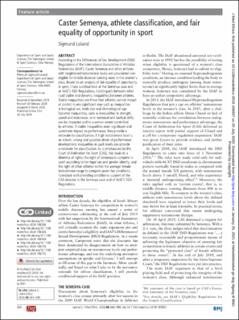| dc.contributor.author | Loland, Sigmund | |
| dc.date.accessioned | 2021-02-02T07:11:24Z | |
| dc.date.available | 2021-02-02T07:11:24Z | |
| dc.date.created | 2020-10-22T16:23:29Z | |
| dc.date.issued | 2020 | |
| dc.identifier.citation | Journal of Medical Ethics. 2020, 46(9), 584-590. | en_US |
| dc.identifier.issn | 0306-6800 | |
| dc.identifier.uri | https://hdl.handle.net/11250/2725688 | |
| dc.description | Free BMJ article. No commercial re-use. | en_US |
| dc.description.abstract | According to the Differences of Sex Development (DSD) Regulations of the International Association of Athletics Federations (IAAF), Caster Semenya and other athletes with heightened testosterone levels are considered non-eligible for middle distance running races in the women's class. Based on an analysis of fair equality of opportunity in sport, I take a critical look at the Semenya case and at IAAF's DSD Regulations. I distinguish between what I call stable and dynamic inequalities between athletes. Stable inequalities are those that athletes cannot impact or control in any significant way such as inequalities in biological sex, body size and chronological age. Dynamic inequalities, such as inequalities in strength, speed and endurance, or in technical and tactical skills, can be impacted and to a certain extent controlled by athletes. If stable inequalities exert significant and systematic impact on performance, they provide a rationale for classification. If high testosterone level is an inborn, strong and systemic driver of performance development, inequalities in such levels can provide a rationale for classification. As is emphasised by the Court of Arbitration for Sport (CAS), this leads to a dilemma of rights: the right of Semenya to compete in sport according to her legal sex and gender identity, and the right of other athletes within the average female testosterone range to compete under fair conditions. I conclude with providing conditional support of the CAS decision in the Semenya case and of IAAF's DSD Regulations. | en_US |
| dc.language.iso | eng | en_US |
| dc.subject | applied and professional ethics | en_US |
| dc.subject | distributive justice | en_US |
| dc.subject | sexuality | en_US |
| dc.subject | gender | en_US |
| dc.title | Caster Semenya, athlete classification, and fair equality of opportunity in sport | en_US |
| dc.type | Peer reviewed | en_US |
| dc.type | Journal article | en_US |
| dc.description.version | publishedVersion | en_US |
| dc.rights.holder | © Author(s) (or their employer(s)) 2021 | en_US |
| dc.source.pagenumber | 584-590 | en_US |
| dc.source.volume | 46 | en_US |
| dc.source.journal | Journal of Medical Ethics | en_US |
| dc.source.issue | 9 | en_US |
| dc.identifier.doi | 10.1136/medethics-2019-105937 | |
| dc.identifier.cristin | 1841612 | |
| dc.description.localcode | Institutt for idrettsmedisinske fag / Department of Sports Medicine | en_US |
| cristin.ispublished | true | |
| cristin.fulltext | original | |
| cristin.qualitycode | 2 | |
